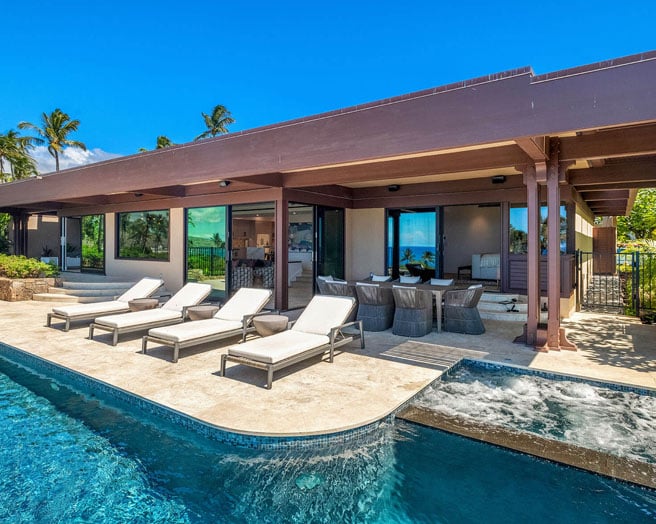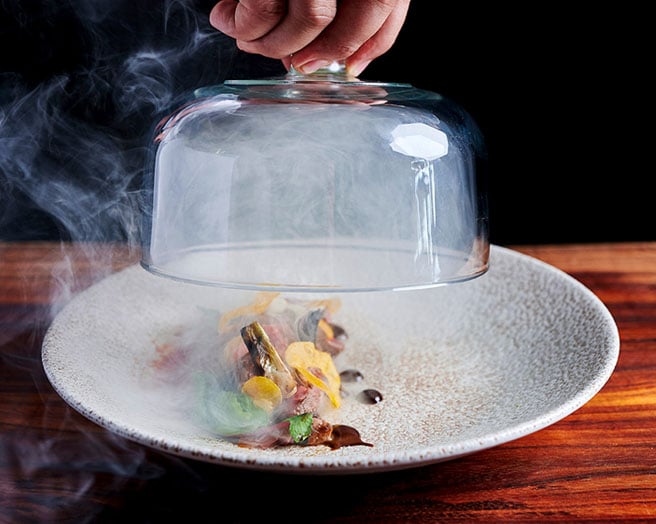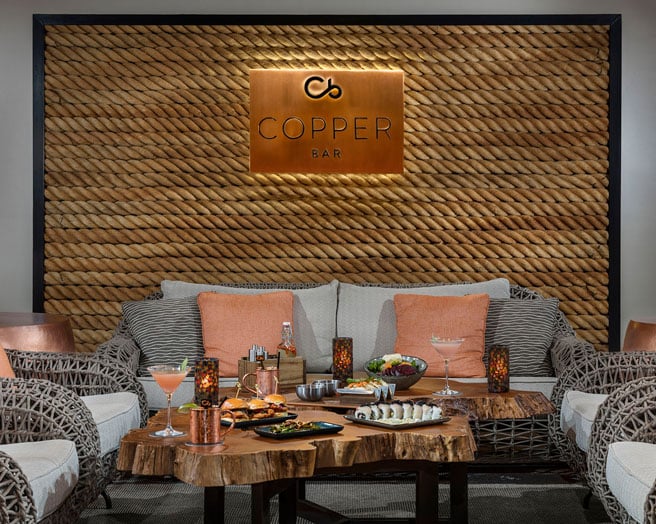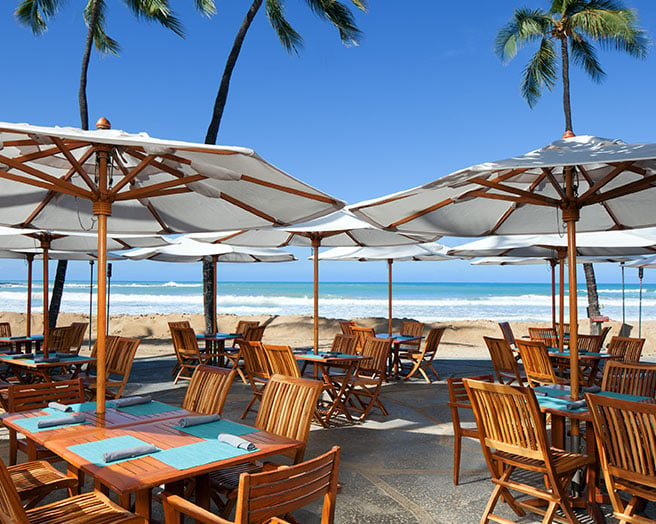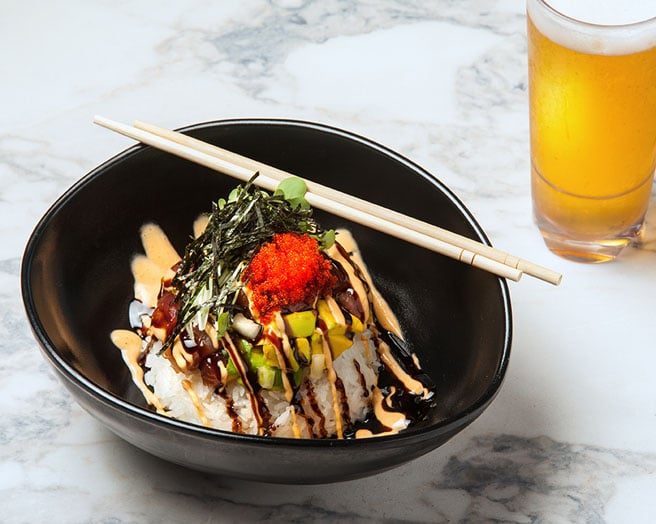Diamonds of the Sea
By Sara Stover
Off Keāhole Point, the westernmost point of Hawai‘i Island, just a half mile from where the ocean meets the lava rocks, floats an unusual menagerie of pyramids. As the sun rises over Hualālai, only two are visible. By noon, five surface, creating a striking contrast with the expanse of deep blue water around them.
“You’re seeing net pens that are actually diamond-shaped. There are eight total, and each pen can hold up to 140,000 Hawaiian kanpachi. We raise the pens for several hours during the day, and the sunlight kills any algae that may grow on the cages. So no chemicals are needed to clean them,” says Dick Jones, CEO at Blue Ocean Mariculture. “Then we lower the pens at night to keep the fish safe. Each pen can be lowered down until the top is 20 feet from the water’s surface. It’s calmer for the fish down there, and they’re safe during high winds and storms.”
As the name suggests, Blue Ocean specializes in mariculture, raising kanpachi in their natural environment of the open ocean to ensure a healthy and sustainable food source. The only open-ocean fin fish aquaculture company in the U.S., Blue Ocean Mariculture began as a project in Natural Energy of Hawai‘i Authority’s (or NELHA) Hawai‘i Ocean Science and Technology (HOST) Park at Keāhole Point in 2001. With one net pen offshore, Blue Ocean closely and consistently monitored the health of the fish, the water quality and potential impacts on the environment to demonstrate how offshore aquaculture could become a viable business model for the State of Hawai‘i. Eight years after launching the demonstration project, the company proved its point by becoming the first and only commercially operating offshore farm to raise finfish in the U.S., specifically Hawaiian kanpachi, an emerging species in oceans worldwide. The fish formerly known as Kona kampachi is also called Almaco Jack (Seriola rivoliana).
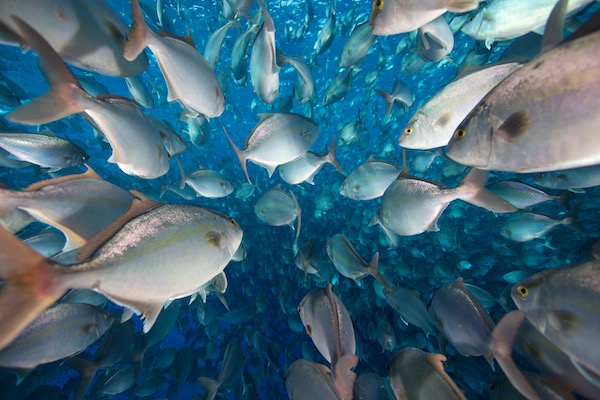
“In Hawai‘i, it’s kahala. In Japan, it’s kanpachi. See the young fish in that tank? They have bands over their eyes, which look like the Japanese symbol for the number eight or ‘pachi,’ and ‘kan’ is Japanese for the center. So ‘kanpachi’ translates to ‘center eight,’” says Blue Ocean’s marketing coordinator, Staci Lovell, who leads a tour of the company’s hatchery at HOST Park. Across the street, families line up outside of Ocean Rider, a seahorse aquafarm that is also part of HOST Park’s collaborative community.
With its 3,290-acre Ocean Research Corridor, HOST Park’s seawater supply system is the world’s only three-pipe seawater delivery system available on demand 24/7, pumping more than 20 million gallons a day. The dual water pumping systems harness both surface and deep sea water, and since sea water is brought to land in high quantities, it has become the ideal place for tenants like Blue Ocean Mariculture.
The area where HOST Park is located has a rich history of native Hawaiian fish farming practices that date back at least 1,000 years ago. It was once the site of Pā‘aiea, a Hawaiian loko i‘a (fishpond) that thrived until the 1801 eruption of Hualālai destroyed it. Pā‘aiea allowed smaller fish to enter the ponds through a weir-type structure. Once in the loko i‘a, fish fed on the site’s rich vegetation until they were big enough to harvest. Today, loko i‘a, which are still in existence, provide a natural habitat for fish. Inspired by this remarkably sustainable way to raise fish, Blue Ocean Mariculture grew from a project to a company with a vision.
“We wanted to not only grow aquaculture fish in Hawai‘i to address food security issues and the needs of the community but do so in an environmentally, socially responsible and economically viable way,” says Dick of Blue Ocean Mariculture, which was officially launched in 2009. Since then, the company has been dispelling long-held myths about mariculture, including the detrimental environmental impacts of some fish farms.
“Mariculture is more focused on the marine ecosystem’s overall sustainability. It differs from onshore farming because it combines the controls of onshore farming with the natural environment of the open ocean,” Dick says, detailing how onshore farming is focused on production and can lead to removing a species from the ocean at a greater rate than that species can naturally restore its population, causing harm to the marine environment. “There’s also a myth that fish farming needs to use chemicals to grow fish, but we’re proving that you don’t if you have clean water and healthy fish from offshore that have a healthy diet.”
In wild populations, kanpachi are susceptible to ciguatera toxins from a parasite they can catch as juveniles. As a result, the finfish are no longer harvested from the wild. Dick explains that being a fully vertically integrated company ensures that Blue Ocean’s kanpachi are parasite-free and safe to eat because they are grown in the controlled environment of the hatchery, bypassing exposure at early stages.
“We have control at every stage, from growing the fish from an egg to getting it harvested, processed and shipped to the customer in a way that meets our high level of food safety and quality,” Dick says, adding that it takes about 15 months to rear the kanpachi from egg to harvest. It all starts with kanpachi wild caught from Hawai‘i waters, which become the parent fish in the hatchery, or broodstock, producing millions of eggs yearly.
At the Blue Ocean hatchery, the broodstock spawns externally every day. The females swim around the tank at an astounding 40 miles per hour and release eggs into the water column. The fertilized eggs float to the top, resembling diamonds, then collected and brought to the nursery, where they hatch into tiny larvae in around 24 hours. The larvae spend their first few weeks of life feeding on rotifers, small zooplankton packed with nutrients, and other tiny marine organisms. Blue Ocean propagates rotifers at the hatchery, making it a plankton farm as well.
Blue Ocean Mariculture raises the juvenile fish in state-of-the-art, land-based facilities. As juveniles grow, they are fed brine shrimp and eventually weaned onto a pellet feed. Once they can school, the fish are transferred to outdoor tanks that best acclimate them to the open ocean they are destined for. It only takes about three months after hatching for the juveniles to reach about 50 grams and be open-ocean ready! The young kanpachi are counted and examined before their short journey to sea on one of Blue Ocean’s barges.
As tall as an 11-story building from tip to tip and shaped like three-dimensional diamonds of the sea, the pens, moored out in waters over 200 feet deep, welcome the young kanpachi to their new home. When the small fish are transferred to the ocean, a smaller net is used within the bigger pen to keep them in. It's removed once they are large enough not to escape through the outer net.
As highly specialized infrastructures, all the pens feature anchoring systems and moorings, keeping the tropical fish safe and eliminating the risk of wildlife entanglement. To preserve seafloor health and water quality, fish-stocking densities are restricted to 3.7 percent of the entire interior volume at total capacity. This offers up to 650,000 pounds of fish ample room to swim around and school while only taking up less than four percent of the volume in the pen. The submersible nature of the pens allows Blue Ocean to raise and lower them, serving as protection for the fish and making it easier to monitor and maintain water quality.
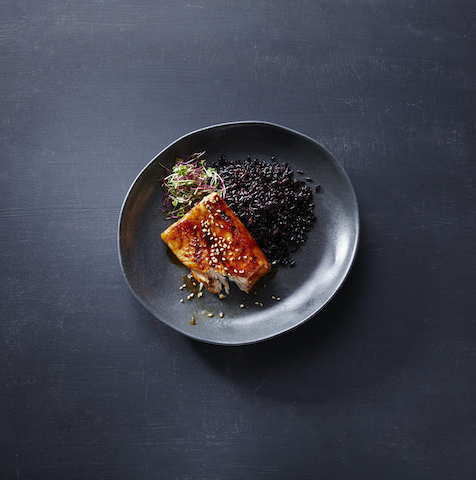
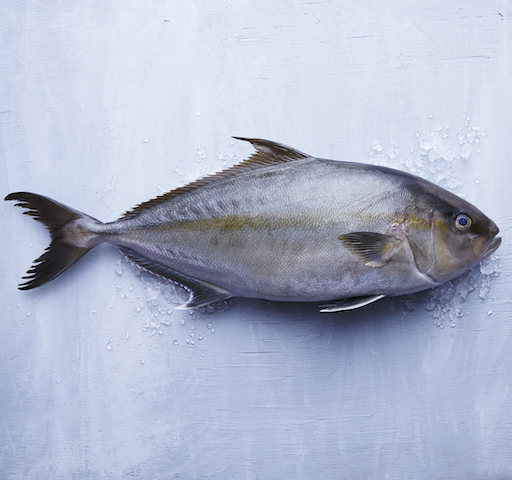
Each pen acts as a floating aggregating device for marine life, attracting everything from baitfish and trevally to barracuda and Galapagos sharks, which swim safely outside the pens. Smaller fish find shelter in the pens and below, and squirrelfish and schools of goatfish can be seen on the reefs.
Above the waves, recreational and commercial fishermen fish around the net pens; and every day, barges and divers visit the pens at feeding time, releasing a large ball of pellets into the pen’s center. Divers also monitor fish behavior, stopping feeding when the fish are no longer eating to inhibit waste. Opening the nets is never necessary, as feeding and harvesting occur through a 14-inch center spar connected to Blue Ocean’s boats via a hose.
Blue Ocean Mariculture currently harvests about twice a week when the kanpachi reach five pounds, which takes around a year. A few thousand fish are caught at a time using the floating internal net and trapped by raising the pen. They’re then pumped into a barge where they are sized. Smaller fish are sent back to the pen, and the other fish are sent down a chute to be iced on board. Drifting past pods of dolphins and flocks of seabirds, the barge heads back to land for processing. By the next day, the Hawaiian kanpachi hit markets across the United States.
Back at NELHA’s main office, palm trees dance in the ocean breeze, and net pens bob on the horizon while Dick explains why Blue Ocean is a game-changer in the world of aquaculture.
“We are trying to feed a global population but keep our roots here in Hawai‘i and leave the ocean in the same or a better place than when we started,” he says.
Blue Ocean can also feed the local community through consistent pricing, quality and availability. On any given weekday, there’s a steady stream of home cooks and gourmet chefs picking up fresh kanpachi from the retail facility down the street from the hatchery. With a clean, subtle flavor, the fish is touted as an outstanding omega-3 fatty acids and lean protein source.
“I founded Blue Ocean Mariculture on the belief that we can grow fish in a way that is responsible and financially viable in a state where food security is a major concern,” says Dick, who points out that since Hawai‘i is dependent on the mainland U.S. (2,500 miles away) for 90 percent of its food, it’s vulnerable to global disruptions in shipping and food supplies. “Blue Ocean can not only address the food security concern by feeding Hawai‘i but provide jobs for the local community, all while demonstrating that we can grow fish in a way that is good for the environment.”
This focus on advancing sustainable development goals by understanding mariculture's challenges and avoiding negative environmental impacts earned Blue Ocean Mariculture a 2024 Sustainability Achievement Award from former Mayor Mitch Roth.
“We’re not just operating a farm raising fish in the open ocean but a farm demonstrating what’s possible when the demand for healthy, reliable mariculture is combined with [a] commitment to enrich our community,” Dick says, drawing on his 38 years of professional experience in the seafood industry. “We can catalyze models for economic growth that leverage the ocean's wealth while restoring its health and prioritizing fish welfare. These models can be replicated around the globe by other sustainable open-ocean aquaculture companies. That’s what creates a blue economy.”
Today, Blue Ocean Mariculture works directly with the National Oceanic and Atmospheric Administration Fisheries and other regulatory and scientific groups to provide insights on water conditions. This ensures that the farm is sustainable and has no negative impact on the ecosystem. The maritime and biological information collected through this collaborative effort is used to evolve with dynamic conditions.
“It means we can really benefit the local ocean economy and the livelihoods of our people now and for future generations to come, all while caring for our fish and protecting the environment,” Dick affirms.
To learn more about Blue Ocean Mariculture’s kanpachi and its efforts to advance a blue economy, visit bofish.com.


